Unichain brings together the achievements of Uniswap, Flashbots, and OP Stack.
Written by: 100y
Translated by: Luffy, Foresight News
A few years ago, I speculated that Uniswap might develop its own network and was opposed due to potential user experience challenges. However, with the unveiling of Unichain, my prediction has proven to be incorrect.
The Unichain white paper is only three pages long, but a closer look reveals it to be a masterpiece. It combines Uniswap's long-standing focus on UX, Flashbots' latest MEV research, and the vast ecosystem built on OP Stack. Although the content is brief, the white paper covers complex topics such as TEE (Trusted Execution Environment), priority ordering, and MEV tax, which may be challenging for readers unfamiliar with the basics of MEV. Therefore, this article aims to quickly and simply introduce the main features of Unichain.
1. Problem
Uniswap is the leading AMM DEX in the Ethereum ecosystem, currently deployed on 25 networks with a total TVL of approximately $4.5 billion. Despite being one of the most successful protocols, it still faces some limitations from the underlying network.
For example, the Ethereum network offers significant liquidity but has low scalability and is susceptible to malicious MEV (Maximum Extractable Value) attacks. Various Rollup solutions have emerged to address these issues, but most Rollups currently have transactions ordered by a single sequencer, leading to potential single points of failure, such as liveness failures and censorship.
Additionally, the block building process on Ethereum and most Rollup networks involves a public mempool, creating an environment where users (searchers) extract MEV from other users. Furthermore, the structure of the MEV value chain creates an imbalance where value is disproportionately captured by proposers rather than benefiting users.
2. Unichain
2.1 Overview
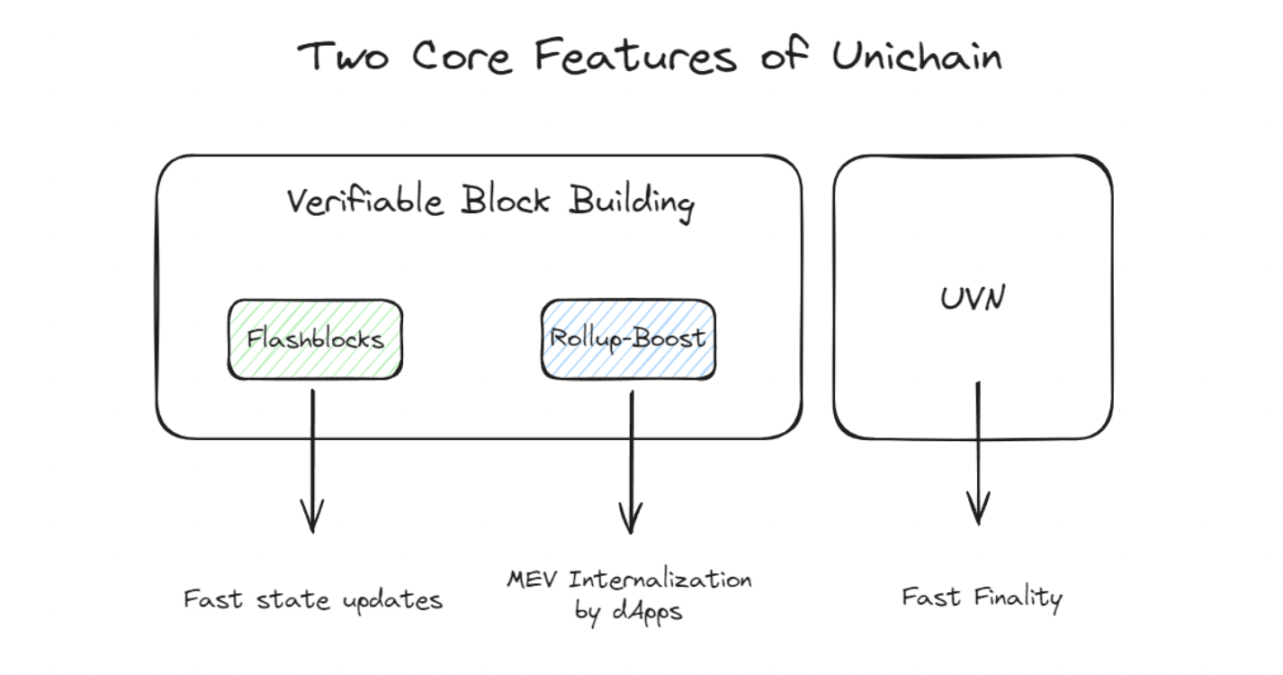
Unichain is an Ethereum Optimistic Rollup based on OP Stack, launched by Uniswap, Flashbots, OP Labs, and Paradigm, aimed at addressing the aforementioned issues. Unichain offers several key advantages through 1) verifiable block building and 2) the Unichain verification network:
- Fast state updates
- Applications can extract and internalize MEV
- Fast settlement through rapid finality
In addition to being a Rollup based on OP Stack, Unichain also plans to participate in the Superchain ecosystem. Besides its native fast settlement capabilities, this integration is expected to provide users with a seamless liquidity experience through cross-chain solutions within the Superchain ecosystem.
Next, let's take a closer look at how Unichain achieves these functionalities.
2.2 Verifiable Block Building
Verifiable block building is achieved through Rollup-Boost, a feature developed in collaboration with Flashbots. Rollup-Boost provides two key functionalities: Flashblocks and verifiable priority ordering. Similar to MEV-Boost, Rollup-Boost can act as sidecar software.
2.2.1 Flashblocks
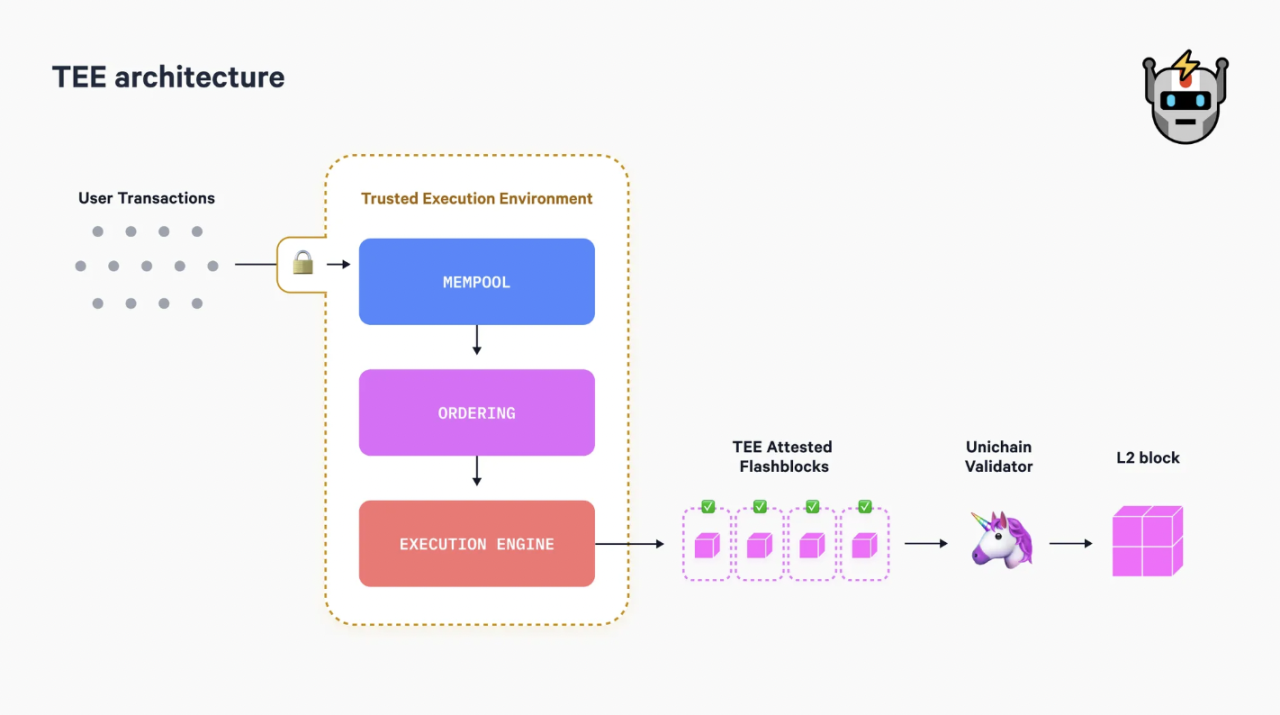
Flashblocks are a pre-confirmation mechanism released by TEE builders (which we will explore in detail below). Unichain generates local blocks, dividing a single block into four parts, creating a local block every 250 milliseconds and sending it to the sequencer.
The sequencer continuously downloads these local blocks while executing transactions, providing users with early execution confirmations. The sequencer guarantees that these local blocks will be included in the final proposed block. This process can accelerate state update speeds, reduce latency, improve user experience, and mitigate malicious MEV.
2.2.2 Verifiable Priority Ordering
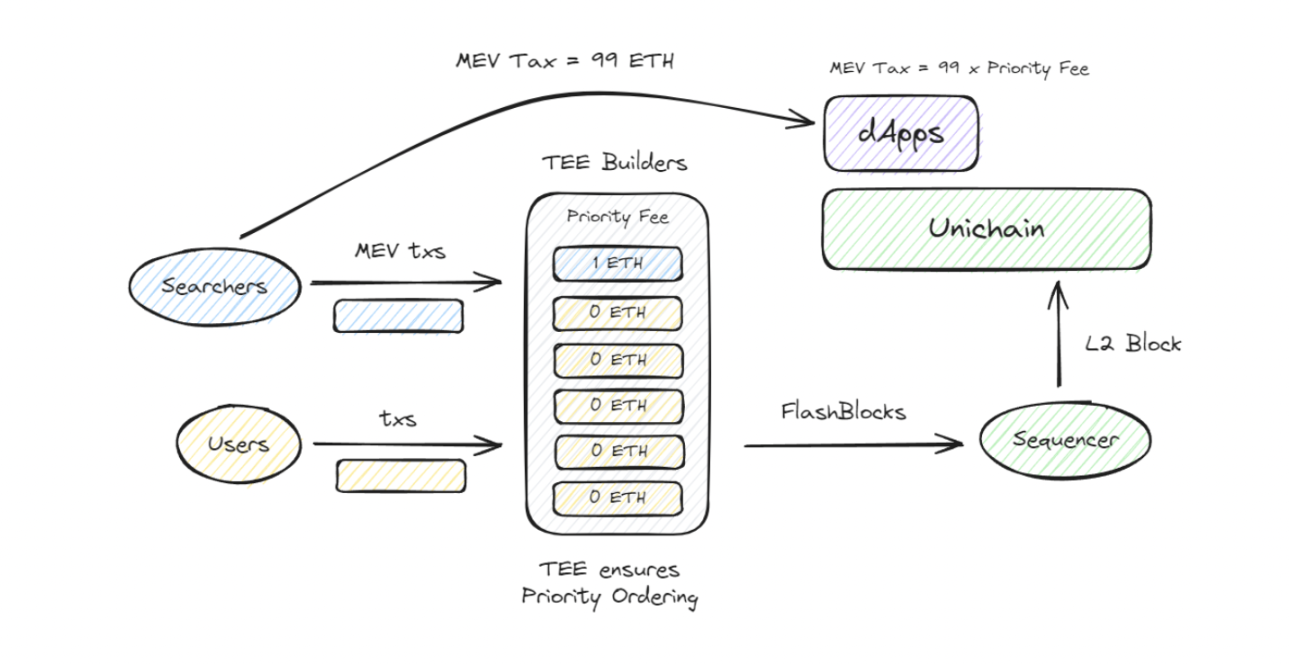
2.2.2.1 Priority Ordering
Priority ordering is a block building mechanism proposed by Paradigm's Dan Robinson and Dave White. It assumes that block proposers order transactions solely based on priority fees, without censorship or delay operations. This model is only feasible when there is a single or trusted block proposer. In competitive environments like Ethereum L1, where multiple proposers build blocks, priority ordering is not viable.
The purpose of private orders is to allow DApps on the mainnet to levy MEV taxes on transactions interacting with them, thereby extracting a portion of the MEV value. This value can be used internally by the DApp or redistributed to users. MEV tax is a fee imposed by smart contracts on transactions, set according to the transaction's priority fee. Let's look at an example.
The 100y DEX on Unichain L2 wants to extract MEV value directly from MEV transactions occurring at its exchange. Since it knows that blocks on Unichain are built using priority ordering, it means that the MEV value of any transaction is entirely determined by its priority fee. The MEV tax set by the 100y DEX equals 99 times the transaction's priority fee.
If an arbitrage opportunity worth 100 ETH arises, how much priority fee is the searcher willing to pay to capture it? The answer is 1 ETH. Setting the priority fee to 1 ETH results in an MEV tax of 99 ETH, with a total cost of 100 ETH. If the priority fee set by the searcher exceeds 1 ETH, the total cost will exceed 100 ETH, resulting in a loss. Therefore, the 100y DEX can capture a maximum of 99 ETH of the 100 ETH MEV value.
For ordinary users who do not capture MEV value, the priority fees will be set much lower, meaning the 100y DEX will not extract value from these transactions. Instead, it will only capture the MEV value represented by the priority fees. This setup allows applications to directly extract MEV, creating various new potential use cases.
2.2.2.2 Verifiable? Using TEE
The key here is to ensure that the entity responsible for block building uses the priority ordering mechanism. To achieve this, Unichain implements two measures: 1) it separates the sequencer and block builders, similar to the PBS model; 2) it mandates that block builders use TEE (Trusted Execution Environment) to allow anyone to verify whether the priority ordering mechanism is being adopted.
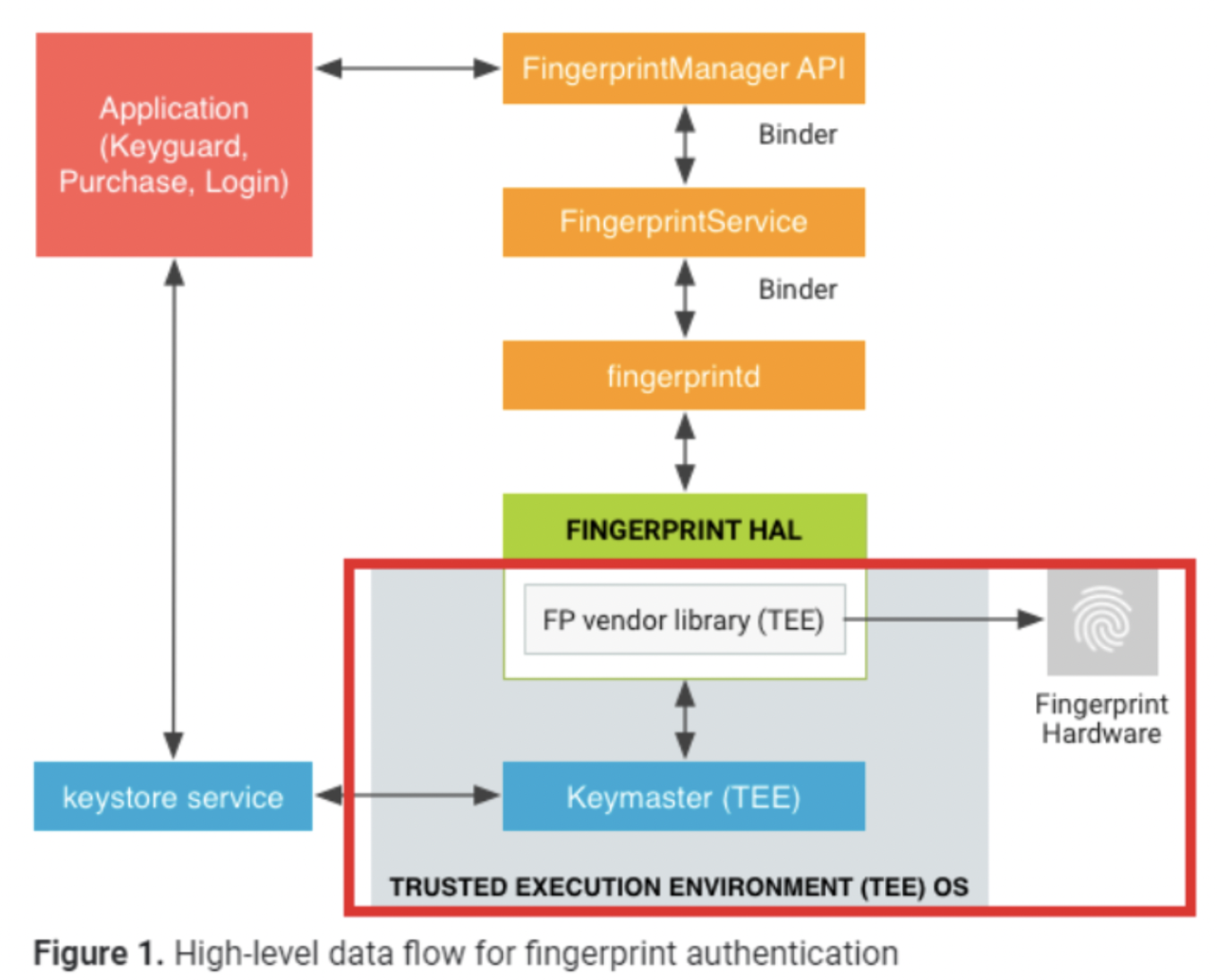
TEE is a secure part within hardware (such as a CPU) that runs independently of the rest of the system to securely handle sensitive data. TEE ensures that trusted code can run securely, unaffected by external environment compromises, such as ARM's TrustZone and Intel's SGX.
This design can even prevent operating systems or programs with administrative privileges from accessing the secure area. To ensure that the code running in TEE is trustworthy, we use attestation. This verification ensures that TEE remains secure and untampered. For example, in Intel SGX, a hash is generated to represent the code and data within SGX, while a hardware-managed private key can prove the integrity of the code.
The block building process of Unichain occurs within the TEE of the TEE builders. Thanks to the characteristics of TEE, these builders can first submit a proof to demonstrate to users that they are using the priority ordering block building mechanism. This combination of features ensures that applications on Unichain can reliably extract a portion of MEV revenue.
2.3 Unichain Verification Network
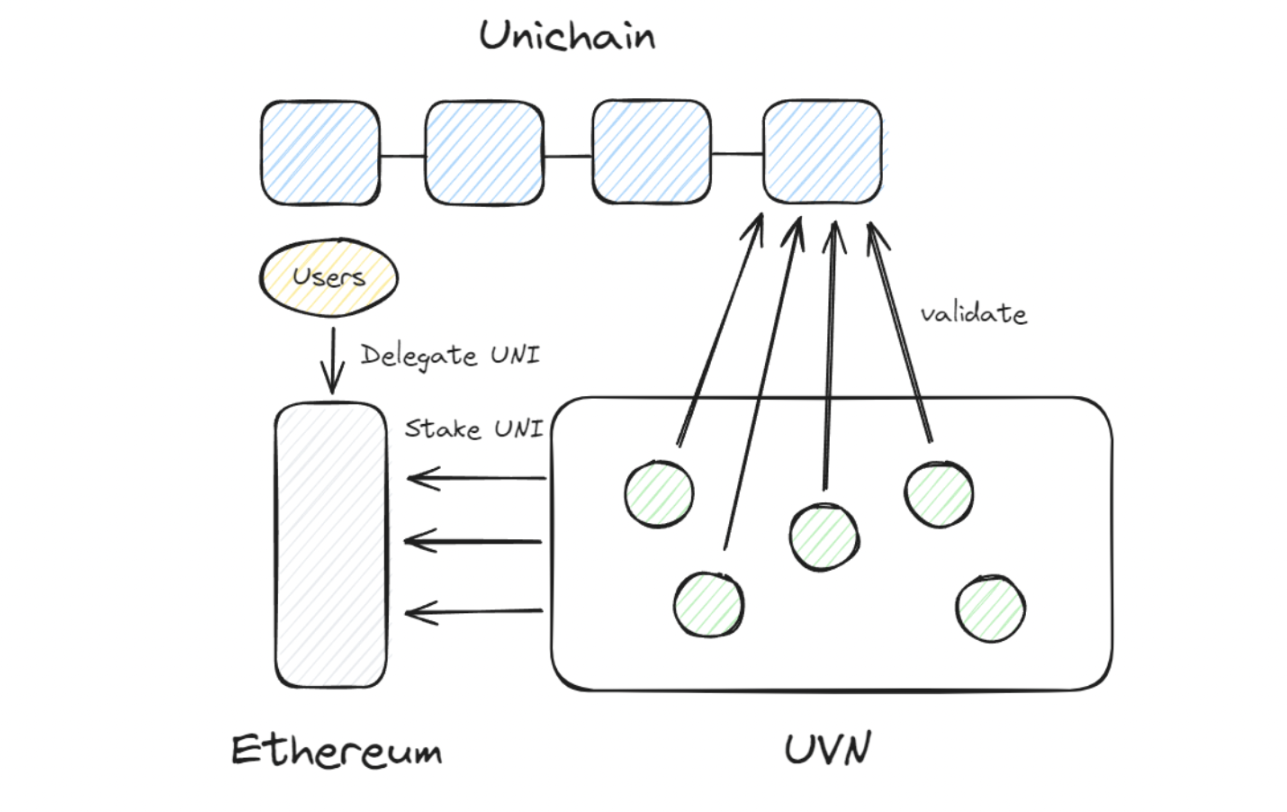
The Unichain verification network is a decentralized network composed of node operators responsible for verifying the latest state of Unichain and providing rapid finality, achieving seamless cross-chain transactions through economic security. This concept is similar to AltLayer's MACH, which uses EigenLayer to achieve rapid finality.
To become a decentralized node in Unichain, participants must stake UNI on the Ethereum mainnet. Each period, the nodes with the highest staked UNI balance will be selected into the active validator set and participate in verification by running the Reth Unichain client. Additionally, similar to other networks, UNI holders can choose to delegate their staking.
3. Final Thoughts
As a DApp, Uniswap has achieved a strong product-market fit, and I am very optimistic about its transition to a dedicated L2. However, since liquidity fragmentation remains a challenge, it will be important to watch how the Uniswap team provides a seamless cross-chain trading experience between Ethereum L1 and Unichain L2.
From an investment perspective, the UNI token will now serve as the staking token for UVN, which is particularly interesting. Given the strong performance of staking protocols like EigenLayer, Symbiotic, and Karak, we can expect a significant amount of UNI to be staked in UVN, which will greatly enhance the value growth of UNI.
免责声明:本文章仅代表作者个人观点,不代表本平台的立场和观点。本文章仅供信息分享,不构成对任何人的任何投资建议。用户与作者之间的任何争议,与本平台无关。如网页中刊载的文章或图片涉及侵权,请提供相关的权利证明和身份证明发送邮件到support@aicoin.com,本平台相关工作人员将会进行核查。




